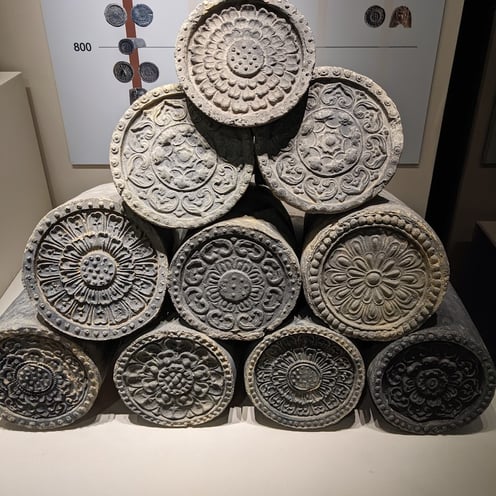Mounds, Masks, Museums and Fire!
Exploring the history-rich towns of Gyeongju and Hahoe Cultural Village near Andong
COUNTRIES
Having returned from Jeju much more efficiently (ferry=12 hrs, plane=<1 hrs), we immediately bussed on from Busan to Gyeongju. Marketed as an open air museum, Gyeongju was once the capital of Korea during the Silla Dynasty (57 BCE – 935 CE). One of the main attractions was immediately apparent as we left the front steps of our simple but pleasant guesthouse: a park down the block with singular grass covered hillocks. Although one might think they are purpose built for rolling down, the hillocks are actually royal burial mounds and climbing them is therefore (quite understandably) prohibited. There are hundreds of these mounds in this region, with dozens right inside the town, housed in lovely and well maintained parks.
On our first jaunt around town, we were able to view a number of them, as well as enter mini-museum, which showed one such excavated mound. While these mounds were not as architecturally impressive as other tombs I've seen, they were grand backdrop to a picturesque town.
And I mean picturesque! Apparently, using a tool from my own trade, zoning, building styles were required to reflect the traditional clay-shingle covered gable roofs of traditional villages.1 2 Virtually every building in the core of town was therefore constructed in this fashion, including the 7/11 and the Starbucks. The result is probably maddening for developers but very easy on the eyes. We loved all the shops and cafes and food stands that lined narrow streets and mound-filled, flower-planted parks, and in the end proved to be one of our favorite places to stay for a while in all of South Korea.
Along with the historic core of town, there were lovely paths along the river that ran through town, and we rented bikes one day to bike along the river to Lake Bomun, a few miles away. Along the route, we stopped in a nice botanic gardens with multiple glass greenhouse buildings filled with tropical trees and plants. Along with the lake, I had another destination in mind: a traditional teahouse suggested in my Rough Guide Guidebook. The teahouse was a little difficult to find and we took several wrong turns before finally triumphing.
The teahouse did not disappoint, featuring a menu of at least 30 high quality Chinese, Taiwanese, Japanese, and Korean teas to try. I ordered Taiwanese Rock Oolong and the shop owner proceeded to prepare the tiny pot and small tea-bowls, rinsing each with hot water, discarding, adding the tea leaves to the pot, shaking and letting me smell before finally pouring in the first water steeping. She left a separate hot kettle nearby so I could pour my own second, third, and fourth steeping. We got tiny tasters of dried fruit and little cookies to go with it, and in the end she also let us try a Korean green tea on the house that I liked even better. Poor Shadie, not wanting to mess with the expensive fancy teas, ordered a more simple cup of ginger tea, which ended up being far too sweet. He enjoyed sips of several steepings though.
After 4 days, we bid goodbye to Gyeonju and headed off to Andong, the jump-off point for another historic center: the Hahoe Cultural Village. I specifically wanted to come here because I had read that a traditional mask festival was happening that weekend, but we initially regretted coming here when Andong proved less picturesque and with the least reliable buses we'd thus encountered. Our hotel turned out to be quite odd, with no discernable front entrance. We wandered up multiple floors before finally happening upon a guy in a booth who handed us a key to our room, which was very large but a bit disturbing, featuring black and white striped walls, a PC desktop that looked like it was from 1995 and a can of bug-killer spray.
On our second day in Andong also started off a bit wobbly. We wanted to go to Hanoe Cultural Village (approximately an hour away) but could not figure out what buses went there or when they left. Reluctant and hoping it was worth it, we hailed a taxi instead and ate tolerable (but still much more steep cost than the bus) cost of a private journey to our destination. We arrived at the entrance to what we thought was the Mask Museum on the map and a small grouping of restaurants. Still confused about the nature of things here, we wandered into the Information Center. Info Centers are quite prolific in South Korea and frequently have free pamphlets (and sometimes postcards) but rarely staff that speak English. I was delighted here to be immediately approached by the tour-guides here. Our guide (who we sadly never got the name of!) spent a good 15 minutes walking me through the map of attractions in the village, explaining special events that were taking place as a part of the Festival, and what transport to take when.
And then she decided she would just show us around herself, proceeding to guide us around for nearly two hours, introducing us to various staff and residents (more on this in a moment), translating for us through several activities, including writing our family motto in chinese characters3, and sipping Chrysanthemum in a free tea ceremony, and leaving a paper wish with a tree goddess. One of the really unique things about this particular historic village (one of many Hanok villages preserved across Korea) is that it is still actively lived in by the same Clan family that founded it more than five-hundred years ago. Several of the people we were introduced to on the tour were in fact, part of that clan and still bore the same family name.
Our guide finally sent us off to watch mask theatre performance. According to our lovely guide, the mask theater was tradition practiced mostly by lower class citizens. Unable to express their frustrations with the upper classes openly, they used these masked plays to make fun of the wealthy. The two short plays we saw were quite crude, including cutting off some bulls balls and trumpeting them around while comparing with disdain to rich men, and a Buddhist monk laughing a pretty lady who tried to pee outside while no one was watching, before seducing her and the two running off together.
Our guide had strongly recommended sticking around Hahoe Village into the evening to watch some kind of festival activity along the riverfront involving fire rather than heading back into Andong. We were a little nervous about this, since there was supposedly only one shuttle that left after 8PM, but could only trust our great guide. So after a nice lunch break (me eating green onion pancake, and Shadie a whole fried fish), we started walking back towards the riverfront in the crisp dusk air. On the walk, I overheard some English speaking fellows behind us. I had been longing to chat with other travelers for a while but we'd rarely encountered other English speakers thus far. So I rustled up my courage and broke into their conversation. Turns out both gentleman, Walder (sp? wish I could remember) and Piedro, were in short-term visiting graduate programs at a university south of Seoul. Walder was from the Netherlands and Piedro from Italy and they were roommates during their time in the country. They were both friendly and great fun. We walked down to the shore together and hung out for the rest of the evening.
The vague fire festival performance we'd been directed to with little expectation turned out to be nothing short of magical. Conducted one time per year during the Mask Festival, the tradition actually had roots in a different tradition of poets that would compose their writings while out on boats on the river enjoying its beauty. For some reason still unclear to me, one of their activities was to race to finish their poems before a lit candle floated downstream reached the boat, after which giant kindling bunches would be tossed off a cliff into the river! Our evening started with some live musical performances while the many guests settled onto the sand along shore adjacent to five ropes that spanned the river to the opposite cliff. As the light faded and the music continued, a light show was projected onto the opposite cliff while fast-working festival workers lit what looked like 2 ft long sparklers on their own line and then sent out by some kind of pulley system onto the main ropes strung over the river. As more and more sparklers were lit, it seemed to form a giant drape of slowly falling showers of yellow sparks across the river. But this wasn't the whole show. Soon a woman spoke over the loudspeaker, enticing the crowds to count down from five, after which giant brands of sticks were li on fire and tossed into the water from the opposite cliff! But that's not all folks! Soon a boat on the water lit up, revealing traditionally dressed men and women fanning themselves in a slow dance as the boat worked its way upstream. Little candles floated down in the opposite direction. But that's not all folks! The finale performance was fireworks over the cliffs, as the sparklers continued to send fireflies across the river. It was better than any new years or 4th of July performance I've ever encountered and ton of fun!
Lucky for us, our new friends, had rented a car for their visit and they kindly offered to drive us back onto Andong. We were all peckish and wandered the streets of Andong looking for late night eats, eventually finding an alley full of little korean BBQ joints and sat outside, grilling unidentified meats and recounting the experience and our travels. It had turned out to be a great two days after all! The next day we headed on the Gangneum and much more modern delights.
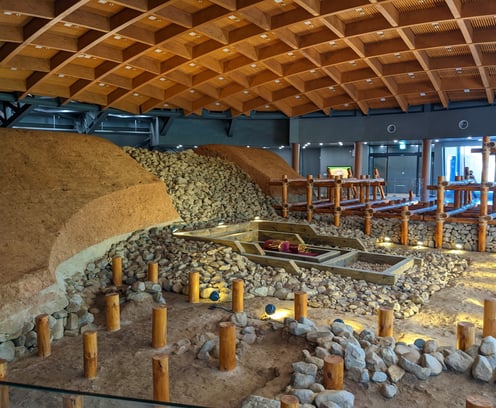

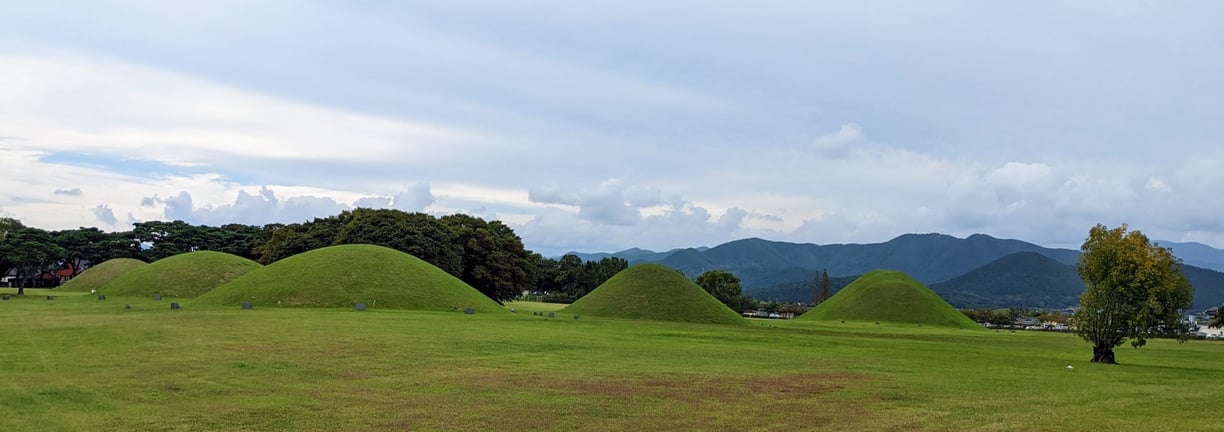

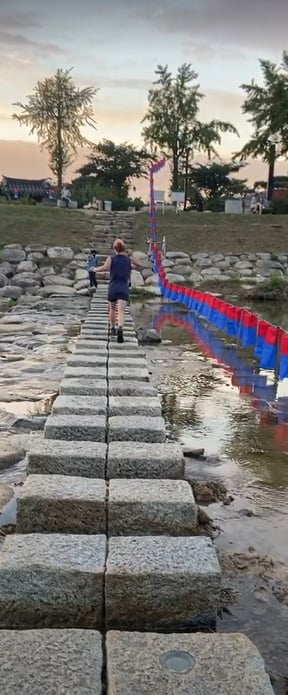

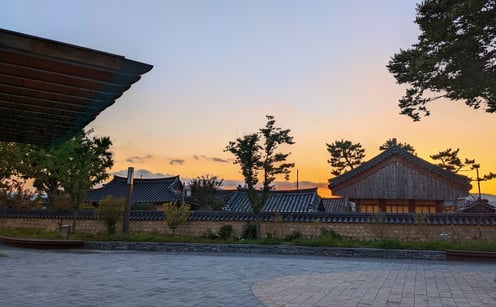

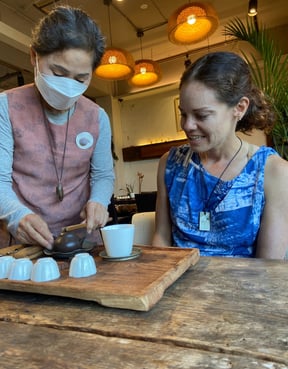

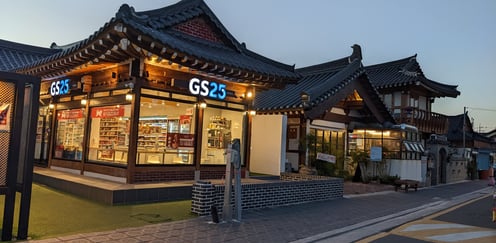

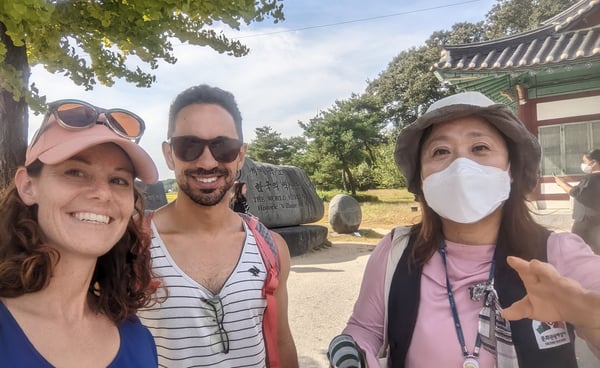

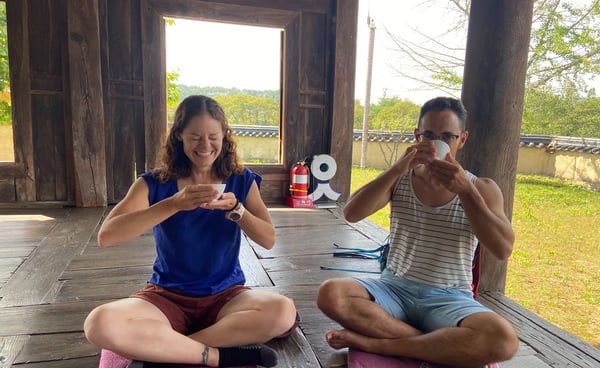

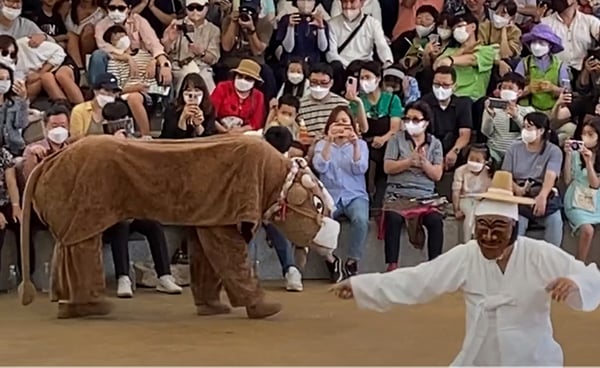

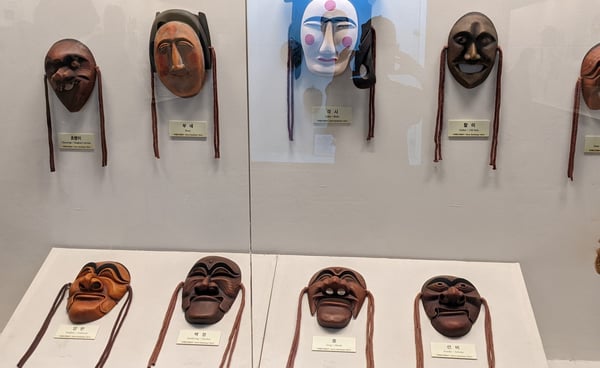

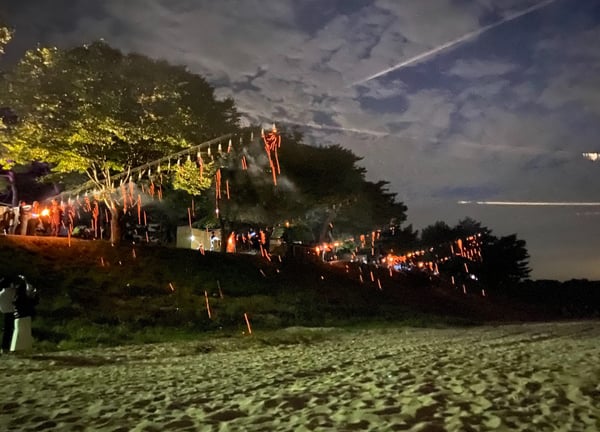

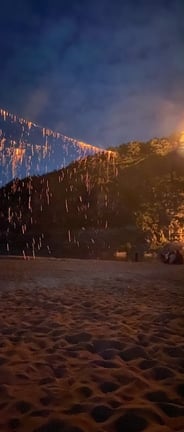

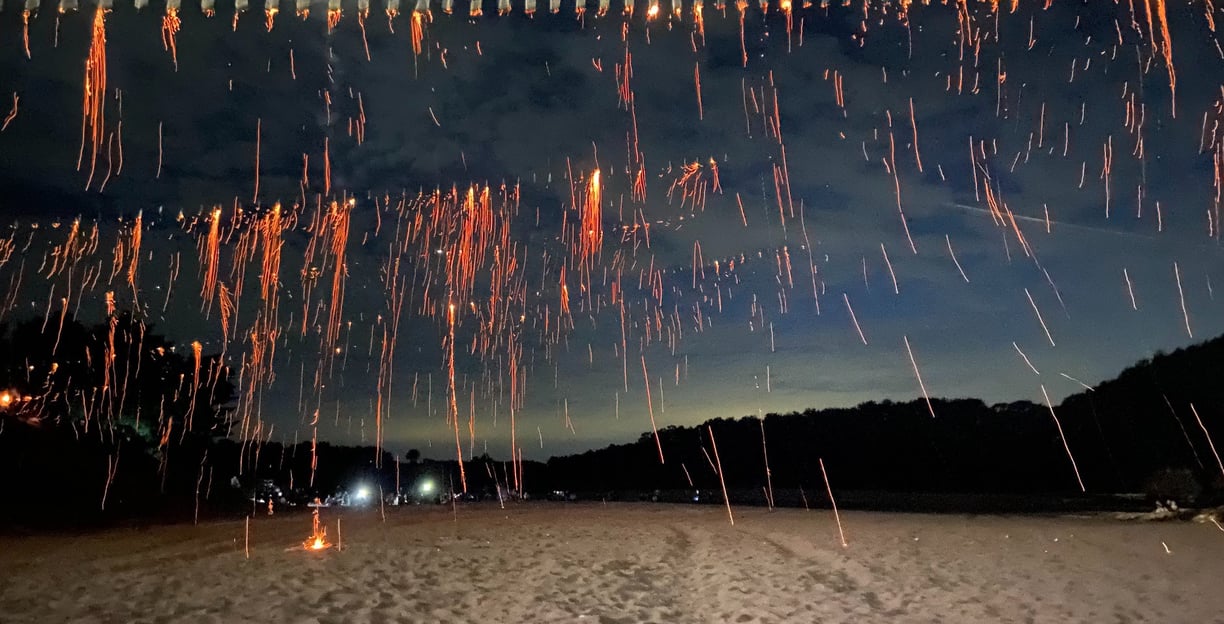

In these tombs, the wooden coffin lowered into a larger box, along with valuable objects (gold crowns, swords, etc.). Then they stacked a ton of large round stones and a layer of dirt for grass to grow back.
Our lovely, english-speaking guide, never offered her name and was also somewhat camera shy. She interpreted for us at several amazing experiences in the Hahoe village including more tea!
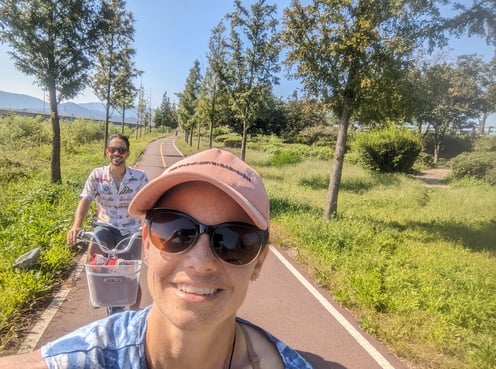

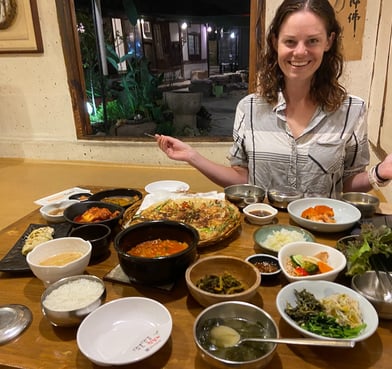

The magic of zoning! GS25 (a corner convenience store) looking like a traditional hanok. The results on the overall skyline were stunning.
I loved the traditional teahouse experience. We both loved our bike ride to get there and the giant traditional korean meal we ate after.
A mask play performance and the traditional masks used for many of these plays. There were eleven traditional masks to representant the characters in these plays in this region.
In the last two photos you can glimpse how the strung the sparklers along the pully and the fire bundles dropped over the cliff.
Footnotes:
1) The zoning ordinance and preservation in Gyeongju, is apparently thanks to Park Chung-hee, a controversial figure that is generally regarded as an authoritarian dictator. His edict of preservation, however meant that the cultural revival of Gyeongju is stronger than ever before. The UNESCO World Heritage Site is separated into five distinct areas, each with its own history and culture.
2) The ceramic shingles and their dramatic cap endings that often feature embossed lotus flowers are their own ceramics artform. The character of the lotus embossing apparently help archeologists date a particular building or site to a particular time period.
3) If Shadie and I were to have a family motto, we decided it would be: "the most difficult paths often lead to the most beautiful places." Our guide noted that this was very similar in spirit to the phrase "no pain, no gain" which is also a korean turn of phrase, so we ended up writing that.
